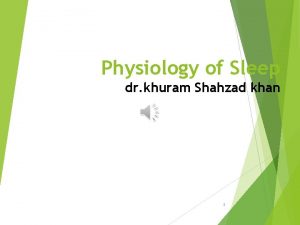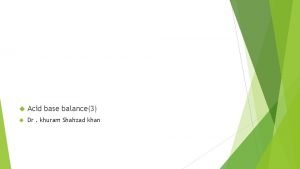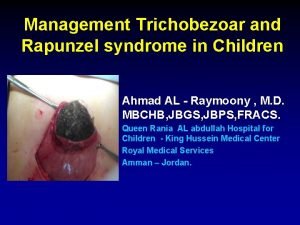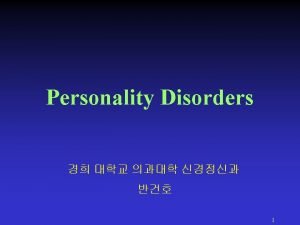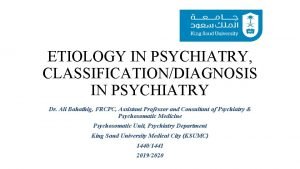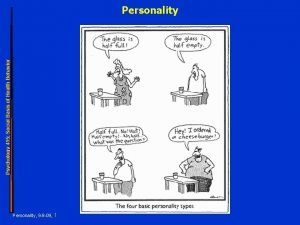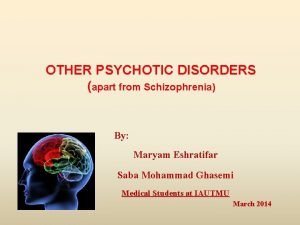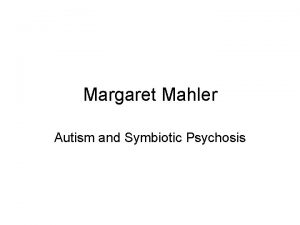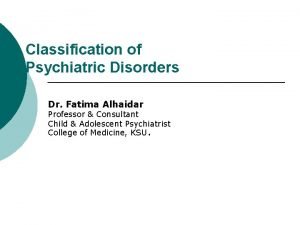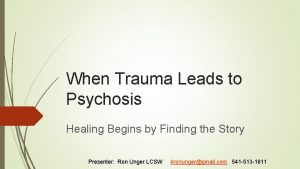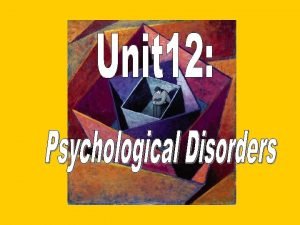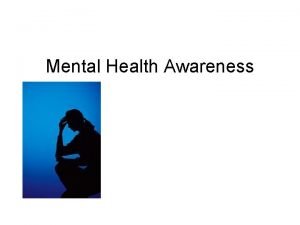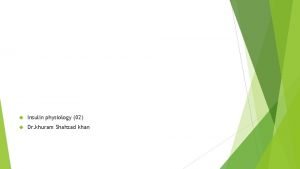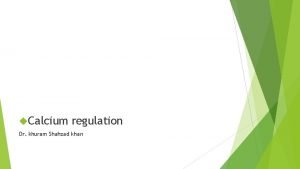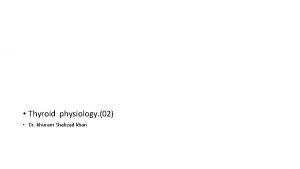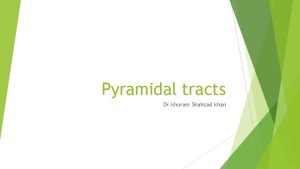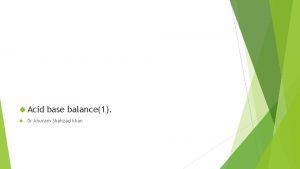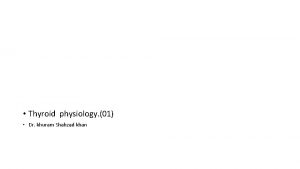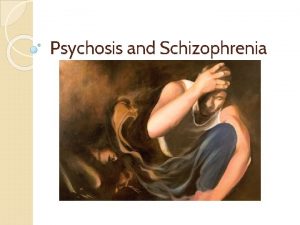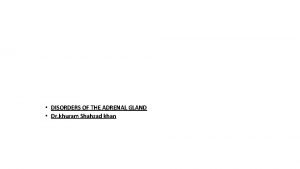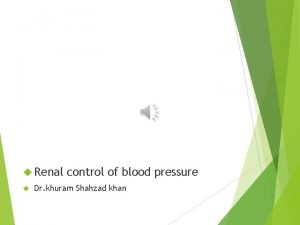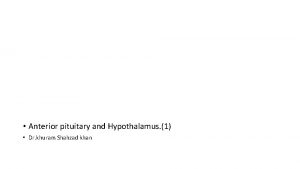PSYCHOSIS SCHIZOPHERENIA DR KHURAM SHAHZAD KHAN What is















- Slides: 15

PSYCHOSIS & SCHIZOPHERENIA DR. KHURAM SHAHZAD KHAN

What is Psychosis? The word ‘psychosis’ is used to describe conditions that affect the mind, where there has been some loss of contact with reality When someone becomes ‘ill’ in this way it is called a ‘psychotic episode’ It is most likely to occur in young people - around 3 in every 100 young people (more common than diabetes!) Most recover fully - It can happen to anyone & can be treated 2

Symptoms of Psychosis can lead to changes in mood, thinking and to abnormal ideas. This can make it hard for even people who know the person best to understand how the person feels. In order to try to understand the experience of psychosis it can be useful to group together some of the more characteristic symptoms The next few slides describe these symptoms 3

Confused Thinking Everyday thoughts become confused or don’t join up properly Sentences are unclear or don’t make sense A person may have difficulty concentrating, following a conversation or remembering things Thoughts appear to be speeded up or slowed down 4

False Beliefs It is common for someone experiencing a psychotic episode to hold false beliefs (delusions) The person may be so convinced of these beliefs that even the most logical counter-arguments may not dissuade them from the belief For example, a person may be convinced that the way that cars are parked outside his house is irrefutable evidence that the police are watching 5

Hallucinations In psychosis, a person may hear, see, smell, taste or feel something that is not actually there. For example, they may hear voices when there is no-one else around and there is nothing else to explain them; or they may see things that other people can’t see. Things may taste or smell as if they are ‘bad’ or even poisoned 6

Changed Feelings In a psychotic episode, how someone is feeling may change suddenly for no apparent reason. The person may feel ‘strange’ or cut off from the world, with everything moving in slow motion. Mood swings are common, veering from unusually excited to very depressed. Peoples’ emotions can be dampened; they feel less able to express their emotion. 7

Changed Behaviour People with psychosis often behave differently from the way they usually do; they may be extremely active or lethargic, sitting around all day. They may laugh inappropriately or become upset and angry for no apparent reason. These changes can be explained by the symptoms previously described - a person who believes they are in danger may call the police; or someone may stop eating if they think that their food is poisoned. 8

Schizophrenia occurs with regular frequency nearly everywhere in the world in 1 % of population and begins mainly in young age (mostly around 16 to 25 years). Schizophrenia is defined by a group of characteristic positive and negative symptoms deterioration in social, occupational, or interpersonal relationships continuous signs of the disturbance for at least 6 months

Definition The schizophrenic disorders are characterized in general by fundamental and characteristic distortions of thinking and perception, and affects that are inappropriate or blunted. Clear consciousness and intellectual capacity are usually maintained although certain cognitive deficits may evolve in the course of time. The most important psychopathological phenomena include thought echo thought insertion or withdrawal thought broadcasting delusional perception and delusions of control influence or passivity hallucinatory voices commenting or discussing the patient in the third person thought disorders and negative symptoms.

Schizophrenia Bleuler coined the notion of the “A’s” of schizophrenia: Affect (flat) Apathetic Avolition Alogia (poverty of speech) Autistic Asocial Anhedonia

Clinical Picture Diagnostic manuals: l. CD-10 („International Classification of Disease“, WHO) DSM-IV („Diagnostic and Statistical Manual“, ) Clinical picture of schizophrenia is according to l. CD-10, defined from the point of view of the presence and expression of primary and/or secondary symptoms (at present covered by the terms negative and positive symptoms): the negative symptoms are represented by cognitive disorders, having its origin probably in the disorders of associations of thoughts, combined with emotional blunting and small or missing production of hallucinations and delusions the positive symptom are characterized by the presence of hallucinations and delusions the division is not quite strict and lesser or greater mixture of symptoms from these two groups are possible

Positive and Negative Symptoms Negative Alogia Affective flattening Avolition-apathy Anhedonia-asociality Attentional impairment Positive Hallucinations Delusions Bizarre behaviour Positive formal thought disorder

The Criteria of Diagnosis For the diagnosis of schizophrenia is necessary presence of one very clear symptom - from point a) to d) or the presence of the symptoms from at least two groups - from point e) to h) for one month or more: a) the hearing of own thoughts, the feelings of thought withdrawal, thought insertion, or thought broadcasting b) the delusions of control, outside manipulation and influence, or the feelings of passivity, which are connected with the movements of the body or extremities, specific thoughts, acting or feelings, delusional perception c) hallucinated voices, which are commenting permanently the behavior of the patient or they talk about him between themselves, or the other types of hallucinatory voices, coming from different parts of body d) permanent delusions of different kind, which are inappropriate and unacceptable in given culture

The Criteria of Diagnosis e) the lasting hallucination of every form f) blocks or intrusion of thoughts into the flow of thinking and resulting incoherence and irrelevance of speach, or neologisms g) catatonic behavior h) „the negative symptoms”, for instance the expressed apathy, poor speech, blunting and inappropriatness of emotional reactions i) expressed and conspicuous qualitative changes in patient’s behavior, the loss of interests, hobbies, aimlesness, inactivity, the loss of relations to others and social withdrawal Diagnosis of acute schizophorm disorder – if the conditions for diagnosis of schizophrenia are fulfilled, but lasting less than one month Diagnosis of schizoaffective disorder - if the schizophrenic and affective symptoms are developing together at the same time
 Khuram khan
Khuram khan Dr shahzad khan
Dr shahzad khan Usman shahzad
Usman shahzad Dr shahzad ahmad
Dr shahzad ahmad Nephrotic syndrome causes
Nephrotic syndrome causes Functional psychosis
Functional psychosis Types of psychosis and neurosis
Types of psychosis and neurosis Neurosis vs psychosis
Neurosis vs psychosis Neurosis and psychosis
Neurosis and psychosis Culture bound syndrome examples
Culture bound syndrome examples Mahler symbiotic psychosis
Mahler symbiotic psychosis First episode psychosis
First episode psychosis Psychological disorders
Psychological disorders Psychosis and ptsd
Psychosis and ptsd Psychosis
Psychosis Types of psychosis and neurosis
Types of psychosis and neurosis
